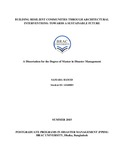| dc.contributor.advisor | Mallick, Professor Fuad H. | |
| dc.contributor.author | Hamid, Samara | |
| dc.date.accessioned | 2015-11-26T06:29:38Z | |
| dc.date.available | 2015-11-26T06:29:38Z | |
| dc.date.copyright | 2015 | |
| dc.date.issued | 2015 | |
| dc.identifier.other | ID 14168003 | |
| dc.identifier.uri | http://hdl.handle.net/10361/4650 | |
| dc.description | This dissertation is submitted in partial fulfillment of the requirements for the degree of Master in Disaster Management, 2015. | en_US |
| dc.description | Cataloged from PDF version of Dissertation. | |
| dc.description | Includes bibliographical references (page 134-136). | |
| dc.description.abstract | The global context and the climate is changing rapidly and this poses a major threat to the population and their habitat to cope with the changing dynamics of the surroundings. Hence, the habitat that house entire communities that in turn build entire nations need to be structured in a safe and robust manner that can easily adapt to adversity. These solutions can be achieved through architectural designs that are affordable, safe, socially /environmentally conscious, socio-culturally appropriate. This paper hence, highlights the architects as professionals who are not only the namesake for mainstream designs but are most vital components in the preparedness and reconstruction phases of the DM cycle capable of achieving sustainability and resilience through interventions.
The concept of architects and architectural interventions is seldom highlighted or appreciated in the disaster management cycle. Therefore, the thesis in its first chapter gradually unveils the concept of the disaster management cycle and its link to approaches that focuses mainly on interventions/solutions that are architecturally related to achieve sustainability.
The subsequent chapter clarifies the link between DM and architecture even further by show-casing examples of countries from all over the world that have been affected by destructive natural calamities and have benefitted through innovative designs. The case-studies were seen through the lens of an architect and the process of reconstruction of each example was outlined for different types of hazard. In doing so, the process revealed the different kinds of architectural interventions or creative solutions in detail that carry the potential of becoming catalysts for a sustainable future.
In the concluding chapter, the process was further analyzed for pros and cons and in this way ideas were presented as to how the projects or solutions can work more effectively and how it can be further improved. The essence of the thesis is to carry forward the concept of architectural innovations and its effectiveness in the DM system so that is can be adopted sooner to see a much more improved and “built back better” world in the approaching times of impending disasters. | en_US |
| dc.description.statementofresponsibility | Samara Hamid | |
| dc.format.extent | 136 pages | |
| dc.language.iso | en | en_US |
| dc.publisher | BRAC University | en_US |
| dc.rights | BRAC University dissertation are protected by copyright. They may be viewed from this source for any purpose, but reproduction or distribution in any format is prohibited without written permission. | |
| dc.subject | Architecture | en_US |
| dc.title | Bulding resilient communities through architectural interventions : towards a sustainable future | en_US |
| dc.type | Thesis | en_US |
| dc.contributor.department | Department of Architecture, BRAC University | |
| dc.description.degree | M. Disaster Management | |

